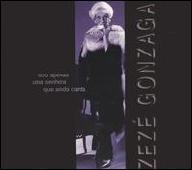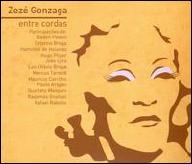The daughter of a luthier and a female flutist, Gonzaga was encouraged by her parents to become an artist, so she took classes on lyrical singing, piano, and sight-reading, starting as a singer at 13 at the Rex club in Além-Paraíba. After a short stay in Rio de Janeiro in 1942, she returned to Porto Novo until her definitive move to Rio three years later, stimulated by the maximum grade obtained at Ary Barroso's show at the Rádio Nacional, when she interpreted Sempre no Meu Coração. She also performed at the Escada do Jacó radio show, hosted by Zé Bacurau, and in 1945, she won first place at the show Pescando Estrelas, hosted by Arnaldo Amaral at the Rádio Clube do Brasil, having been hired by the outing. At the Rádio Clube, Gonzaga met Odaléa Sodré (Heitor Catumbi's daughter), forming with her the duo As Moreninhas do Ritmo, which also performed at the Rádio Jornal do Brasil with the group of the pianist Laerte. In 1948, Gonzaga had a better proposal from Rádio Nacional, so she left Rádio Clube. At the new radio station, she formed the trio As Moreninhas with Bidu Reis and Odaléa Sodré. Gonzaga's first album was recorded in 1949, with the sambas-canção Inverno (Clímaco César) and Desci (Alcir Pires Vermelho/Cláudio Luís). In that period, she also participated in other groups, such as Cantores do Céu and Vocalistas Modernos, also recording several albums for Rádio Nacional as a chorist. Her biggest hit came in 1951 with the bolero Canção de Dalila (Victor Young, version by Clímaco César), recorded with the accompaniment of Lírio Panicali's orchestra and choir. In 1956, Gonzaga recorded her first LP, Zezé Gonzaga, considered the best of the year. Among its successes were Ai Ioiô (Linda Flor) (Henrique Vogeler/Luís Peixoto) and Nunca Jamais (Lalo Ferreira, version by Marques Porto). In the late '70s, she recorded Valzinho/Um Doce Veneno, a tribute to Valzinho in which she was backed by Quinteto de Radamés Gnattali. In the late '80s, she formed, with other old-timers, the group Eternas Cantoras do Rádio, recording two CDs and doing several performances. In 1999, she recorded, together with Jane Duboc, the album Clássicas, doing shows in Rio, São Paulo, and other cities. In the late '90s, she also participated in the show Lupicínio Rodrigues with Áurea Martins in Rio and São Paulo. In 2000, Gonzaga participated in the MPB: A História de Um Século project, together with Paulo Sérgio Santos and Maria Tereza Madeira, an ambitious initiative that intended to review the history of Brazilian popular music in the 20th century. ~ Alvaro Neder, Rovi
Zezé Gonzaga
September 3, 1926 - July 24, 2008 (age 81)
Biography
Considered one of the most beautiful voices of Rádio Nacional in its heyday, Zezé Gonzaga, known especially for her two hits Canção de Dalila (Victor Young/ Clímaco César) and Óculos Escuros (Valzinho/Orestes Barbosa), participated regularly on the radio's prime time, accompanied by the orchestras conducted by Radamés Gnattali, Leo Peracchi, Lírio Panicali, and others. As a composer, she wrote (with Luís Carlos Saroldi) the opening theme of the Minerva project, broadcast nationwide by the Rádio MEC.
Top Tracks
Albums
Videos
Close













